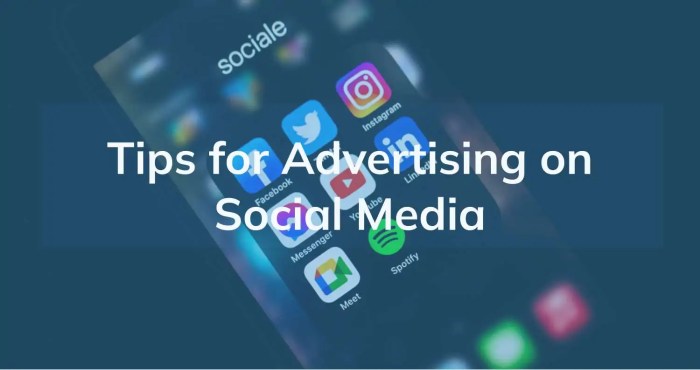Social Media Advertising Tips are essential in today’s digital world for businesses looking to make an impact. From creating captivating content to analyzing key metrics, this guide dives deep into the world of social media advertising.
Overview of Social Media Advertising

In today’s digital marketing landscape, social media advertising plays a crucial role in reaching and engaging with target audiences. With the increasing use of social media platforms by people of all ages, businesses have a unique opportunity to connect with potential customers in a more personalized and interactive way.
Popular Social Media Platforms for Advertising
- Facebook: With over 2.7 billion monthly active users, Facebook offers a wide range of advertising options to target specific demographics and interests.
- Instagram: As a visually-driven platform, Instagram is ideal for businesses looking to showcase products or services through engaging images and videos.
- Twitter: Known for real-time updates and conversations, Twitter allows businesses to promote content and engage with users in a fast-paced environment.
- LinkedIn: Targeting professionals and B2B audiences, LinkedIn is a valuable platform for businesses focusing on networking and lead generation.
Benefits of Using Social Media Advertising for Businesses
- Increased Brand Awareness: Social media advertising helps businesses reach a wider audience and build brand recognition through targeted campaigns.
- Enhanced Targeting Capabilities: With advanced targeting options, businesses can reach specific demographics, interests, and behaviors to maximize the effectiveness of their ads.
- Improved Engagement and Interaction: Social media advertising allows businesses to engage with customers through likes, comments, shares, and direct messages, creating a more interactive experience.
- Measurable Results: Businesses can track the performance of their ads in real-time, allowing for adjustments based on data insights to optimize campaign success.
Strategies for Effective Social Media Advertising: Social Media Advertising Tips
In today’s digital age, social media advertising has become a crucial component of any marketing strategy. To ensure success in this competitive landscape, it is important to implement effective strategies that will help your ads stand out and reach your target audience. Below are some key tips to consider:
Creating Engaging Content for Social Media Ads
When creating content for social media ads, it is essential to grab the attention of your audience within seconds. Here are some tips to make your content more engaging:
- Use eye-catching visuals, such as high-quality images and videos, to capture the viewer’s attention.
- Craft compelling copy that is concise, clear, and relevant to your target audience.
- Incorporate storytelling techniques to evoke emotions and create a connection with your audience.
- Add a call-to-action (CTA) to prompt viewers to take the desired action, such as visiting your website or making a purchase.
Targeting Options Available for Social Media Advertising
Social media platforms offer a variety of targeting options to help you reach the right audience for your ads. Some common targeting options include:
Demographic targeting: Allows you to target users based on age, gender, location, income, education, and other demographic factors.
Interest targeting: Targets users based on their interests, hobbies, behaviors, and interactions on the platform.
Lookalike audience targeting: Helps you find new audiences similar to your existing customers or followers.
Custom audience targeting: Allows you to target users who have previously interacted with your brand, such as website visitors or email subscribers.
The Importance of A/B Testing in Social Media Advertising Campaigns
A/B testing, also known as split testing, is a crucial strategy in social media advertising to optimize your campaigns for better performance. Here’s why A/B testing is important:
- Allows you to compare different variations of your ads to see which one performs better in terms of engagement and conversions.
- Helps you identify the best performing elements, such as visuals, copy, CTAs, and targeting options, to improve future campaigns.
- Provides valuable insights into the preferences and behavior of your target audience, enabling you to tailor your ads for maximum impact.
- Enables you to make data-driven decisions and continuously refine your advertising strategies for better results.
Best Practices for Different Social Media Platforms

When it comes to social media advertising, each platform has its own unique features and best practices to optimize ads and maximize engagement. Let’s dive into some tips for advertising on popular platforms like Facebook, Instagram, Twitter, and LinkedIn.
- Utilize Facebook’s targeting options to reach your specific audience based on demographics, interests, and behaviors.
- Create visually appealing and engaging ads with high-quality images or videos to capture users’ attention in their news feeds.
- Experiment with different ad formats such as carousel ads, video ads, or lead generation ads to see what resonates best with your audience.
- Take advantage of Instagram’s visual nature by focusing on high-quality, visually appealing content that fits seamlessly into users’ feeds.
- Use Instagram Stories and IGTV to create interactive and engaging ad experiences that feel native to the platform.
- Collaborate with influencers or run user-generated content campaigns to leverage the power of social proof and authenticity on Instagram.
- Keep your tweets concise and engaging, utilizing hashtags and mentions to increase visibility and reach a broader audience.
- Run Twitter polls or engage in real-time conversations to drive engagement and foster a sense of community around your brand.
- Use Twitter Ads to promote your tweets, trends, or accounts to target specific audiences and amplify your reach.
- Share thought leadership content and industry insights to establish credibility and engage with a professional audience on LinkedIn.
- Utilize LinkedIn’s targeting options to reach decision-makers and professionals based on job titles, industries, or company sizes.
- Create sponsored content or InMail campaigns to generate leads and drive conversions in a B2B context on LinkedIn.
Metrics and Analytics in Social Media Advertising
In the world of social media advertising, metrics and analytics play a crucial role in determining the success of your campaigns. By analyzing key performance indicators (KPIs) and interpreting analytics data, you can make informed decisions to improve your ad performance and achieve your marketing goals.
Key Performance Indicators (KPIs)
- Click-through Rate (CTR): Measures the percentage of people who clicked on your ad after seeing it. A high CTR indicates that your ad is resonating with your target audience.
- Conversion Rate: Tracks the percentage of users who completed a desired action, such as making a purchase or signing up for a newsletter, after clicking on your ad.
- Engagement Rate: Reflects how users interact with your ad, such as likes, comments, and shares. A high engagement rate indicates that your content is engaging and relevant.
- Return on Ad Spend (ROAS): Calculates the revenue generated from your ad campaign compared to the amount spent on advertising. A positive ROAS means that your campaign is profitable.
Analyzing and Interpreting Analytics Data, Social Media Advertising Tips
- Monitor campaign performance regularly to identify trends and patterns in your data.
- Compare different ad creatives, targeting options, and ad placements to see which strategies are most effective.
- Use A/B testing to experiment with different variables and determine the best-performing elements of your ads.
Adjusting Strategies Based on Analytics Insights
- Optimize your ad targeting based on demographic data and user behavior insights.
- Rework your ad copy and visuals to better align with the interests and preferences of your target audience.
- Allocate your budget towards top-performing ads and adjust bids to maximize ROI.
